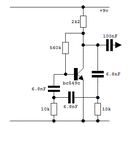neazoi
Advanced Member level 6

Hi this oscillator can be tuned from less than 1khz to more than 3khz by replacing the 10k resistors with a stereo potentiometer.
However, this circuit produces a square wave. I thought it was a phase shift RC oscillator which should produce a sine wave.
What may be the problem?
However, this circuit produces a square wave. I thought it was a phase shift RC oscillator which should produce a sine wave.
What may be the problem?


